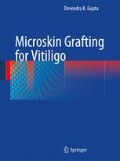Abstract
Ultra thin or thin split thickness skin grafts (STSG-UT, STSG-T) are minced into small skin pieces. The sizes of the small skin pieces varies from 0. 2 to 0. 8 mm and the thickness varies from 0. 15 to 0. 3 mm for the so called “microskin grafts” (MSGs). Ultra-thin grafts of 3–6 thousandth of an inch (0. 08–0. 15 mm) are used for resurfacing. There is less hypopigmentation of the donor site after healing is complete, and reharvesting may be done if needed. Fang et al,1 evaluated dermatome settings from 0. 002 to 0. 012 in. (0. 05–0. 3 mm). First, with feeler gauges, he verified the dermatome settings. Second, he harvested the skin at various dermatome settings and measured the thickness histologically. He found that (1) the der-matome settings are reasonably accurate; (2) harvesting useful sheets at 0. 002 and 0. 004 in. (0. 05–0. 10 mm) is virtually impossible; (3) the variability of histologic graft thickness is enormous; and (4) a dermatome setting of 0. 006 in. (0. 15 mm) yields useful grafts. Further, graft thinner than 0. 006 in. may contain no epidermal stem cells. If the graft contains no epidermal stem cells, it may initially take?? but then disappear over time, as the cells contained in the graft die and are not replaced. He no longer used the term epidermal autografting but rather ultrathin split-thickness grafting. To harvest these grafts, he merely set the dermatome to 0. 006 in. (0. 15 mm) and made all necessary midcourse corrections to obtain translucent grafts.
Access this chapter
Tax calculation will be finalised at checkout
Purchases are for personal use only
References
Fang P, Engrav LH, Gibran NS, et al. Dermatome setting for autografts to cover INTEGRA. J Burn Care Rehabil. 2002; 23(5):327–332.
Billingham RE, Reynolds J. Transplantation studies on sheets of pure epidermal epithelium and on epidermal cell suspensions. Br J Plast Surg. 1952;5:25.
Gabarro P. A new method for grafting. Br Med J. 1943; 1:723.
Nystrom G. Sowing of small skin graft particles as a method for epithelization especially of extensive wound. Plastic Reconstr Surg. 1959;23:226.
Blair SD, Nanchahal J, Backhouse CM, Harper R, McCollum CN. Microscopic split skin grafts: a new technique for 30-fold expansion. Lancet. 1987;2:483.
Nanchahal J. Stretching skin to the limit: a novel technique for split skin graft expansion. Br J Plast Surg. 1989;42:(1): 88–91.
Alexander JW, MacMillan BG, Law E, Kittur DS. Treatment of severe burns with widely meshed skin autograft and meshed skin allograft overlay. J Trauma. 1981;21:433.
Klasen HJ, History of Free Skin Grafting. Knowledge or Empiricism? Berlin: Springer;1981:84.
Rimdeika R, Bagdonas R. Major full thickness skin burn injuries in premature neonate twins. Burns. 31:(1):76–84.
Harashina T, Iso R. The treatment of leukoderma after burns by a combination of dermabrasion and “Chip” skin grafting. Clin Transplant. 21:(2):207–213.
Tsukamoto K, Osada A, Kitamura R, Ohkouchi M, Shimada S, Takayama O. Approaches to repigmentation of vitiligo skins: new treatment with ultrasonic abrasion, seed grafting and psoralen plus ultraviolet a therapy. Pigment Cell Res. 2002;15(5): 331–334.
Zhang ML, Chang ZD, Han X, Ziu M. Microskin grafting. I. Animal experiments. Burns. 1986;12(8):540–543.
Rights and permissions
Copyright information
© 2009 Springer Dordrecht Heidelberg London New York
About this chapter
Cite this chapter
(2009). What Is a Microskin Graft?. In: Microskin Grafting for Vitiligo. Springer, London. https://doi.org/10.1007/978-1-84882-605-2_9
Download citation
DOI: https://doi.org/10.1007/978-1-84882-605-2_9
Publisher Name: Springer, London
Print ISBN: 978-1-84882-604-5
Online ISBN: 978-1-84882-605-2
eBook Packages: MedicineMedicine (R0)

